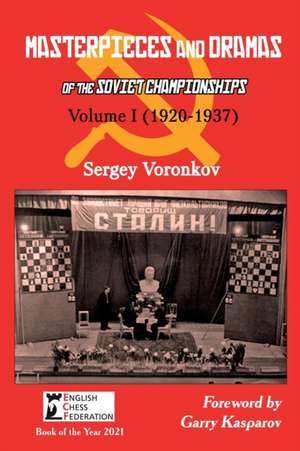Masterpieces and Dramas of the Soviet Championships: Masterpieces and Dramas of the Soviet Championships, cartea 1
Autor Sergey Voronkoven Limba Engleză Paperback – 8 dec 2020
This book can be read on many levels: a carefully selected collection of 107 of the best games, commented on mostly by the players themselves, supported by computer analysis. A detailed and subtly argued social history of the Soviet Chess School and of how chess came to occupy such an important role in Soviet society. A discussion of how the chess community lost its independence and came to be managed by Party loyalists. A portrayal of how the governing body and its leader, Nikolai Krylenko, strived to replace an entire generation of free-thinking chess masters with those loyal to the state. A study of how the authorities' goals changed from wanting to use chess as a means of raising the culture of the masses to wanting to use chess to prove the superiority of the Soviet way of life. Or a sometimes humorous, often tragic history of talented, yet flawed human beings caught up in seismic events beyond their control who just wanted to play chess.
This book is illustrated with around 170 rarely seen photos and cartoons from the period, mostly taken from 1920s-1930s Russian chess magazines.
As Garry Kasparov highlights in his foreword "this book virtually resembles a novel: with a mystery plot, protagonists and supporting cast, sudden denouements and even 'author's digressions' - or, to be exact, introductions to the championships themselves, which constitute important parts of this book as well. These introductions, with wide and precise strokes, paint the portrait of the initial post-revolutionary era, heroic and horrific at the same time. I've always said that chess is a microcosm of society. Showing chess in the context of time is what makes this book valuable even beyond the purely analytical point of view."
| Toate formatele și edițiile | Preț | Express |
|---|---|---|
| Paperback (1) | 267.62 lei 6-8 săpt. | |
| Limited Liability Company Elk and Ruby Publishing – 8 dec 2020 | 267.62 lei 6-8 săpt. | |
| Hardback (3) | 362.62 lei 3-5 săpt. | +45.07 lei 4-10 zile |
| Limited Liability Company Elk and Ruby Publishing – 10 sep 2022 | 362.62 lei 3-5 săpt. | +45.07 lei 4-10 zile |
| Limited Liability Company Elk and Ruby Publishing – 8 dec 2020 | 368.94 lei 6-8 săpt. | |
| Limited Liability Company Elk and Ruby Publishing – 4 dec 2021 | 374.25 lei 6-8 săpt. |
Preț: 267.62 lei
Nou
51.22€ • 52.91$ • 42.62£
Carte tipărită la comandă
Livrare economică 25 martie-08 aprilie
Specificații
ISBN-10: 5604176931
Pagini: 536
Dimensiuni: 156 x 234 x 29 mm
Greutate: 0.74 kg
Editura: Limited Liability Company Elk and Ruby Publishing
Colecția Masterpieces and Dramas of the Soviet Championships
Seria Masterpieces and Dramas of the Soviet Championships
Descriere
The third volume of Sergey Voronkov's epic tale takes the reader on a historical journey through the late Stalinist period in the USSR. It covers in depth the five Soviet championships from 1948 to 1952 and the playoff match between Botvinnik and Taimanov in 1953, which concludes one month before Stalin's death. Against a background of rampant anti-Semitism, a new wave of repressions and descent into the First Cold War, in which chess was an important front, the USSR captures the world chess crown and Botvinnik and the generation that followed him, including Smyslov, Keres, Bronstein, and Boleslavsky, assert their places at the top-tables of Soviet and indeed global chess. Yet a new group of legends begins to emerge, including Petrosian, Geller, Korchnoi, Taimanov, Averbakh, Simagin, Kholmov, and Furman making their championship debuts, as well as a semi-final appearance by Nikitin and Spassky's first quarter-final. At the same time, the reader learns about lesser-known masters Yuri Sakharov and Johannes Weltmander, victims of Stalinism who found solace in chess from their otherwise tragic lives.
The present volume contains 77 games and fragments, once again mostly annotated by the participants and other contemporary masters, augmented with modern computer analysis. It is illustrated with over 220 photos and cartoons from the period. Many of these photos come from unique archives, including that of David Bronstein, and are published for the first time.



